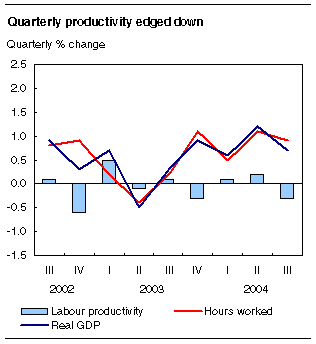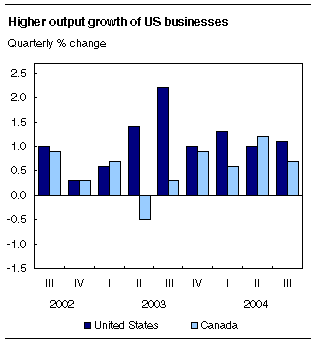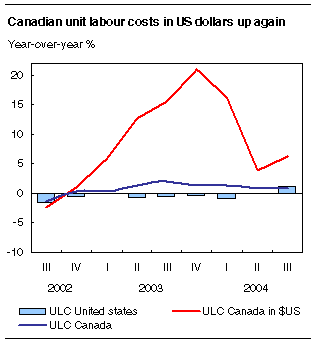
















 |
|
 |                |
Information identified as archived is provided for reference, research or recordkeeping purposes. It is not subject to the Government of Canada Web Standards and has not been altered or updated since it was archived. Please "contact us" to request a format other than those available.

|

Friday, December 10, 2004 Labour productivity, hourly compensation and unit labour costThird quarter 2004With the slowdown in economic activity and the continued rise in hours worked, Canadian business sector productivity edged down 0.3% between July and September. 
With this third quarter slump, productivity continued its lacklustre performance of the previous five quarters. During this period, productivity growth ranged from a 0.2% gain to a 0.3% decline. The lack of productivity gains, combined with the strength of the Canadian dollar, pushed up the unit labour cost in American dollars in the third quarter. This has adversely affected the competitiveness of Canadian businesses compared with their American counterparts. Labour productivity, measured as real GDP per hour worked, is an important contributor to the improvement of living standards and the competitiveness of businesses.
The growth in hours worked remained steady between July and September 2004, while output slowed, giving rise to a productivity decline. In the United States, productivity increased by only 0.6% in the third quarter, after gains of 1.0% in the first quarter and 0.7% in the second quarter. Over the past four quarters, US productivity has grown an average of 0.7% per quarter. This is the sixth straight quarter in which Canadian businesses have posted lower productivity than their American counterparts. Slowdown in GDP but a stronger Canadian labour marketGrowth in real GDP in the third quarter south of border outpaced that in Canada, a reversal of the situation in the second quarter. Growth in GDP of Canadian businesses slowed in the third quarter (+0.7%) and was about half the pace achieved in the previous quarter (+1.2%). This slowdown is primarily attributable to the 0.5% drop in exports and the 3.1% increase in imports. Essentially, GDP growth came from final domestic demand, as consumer spending picked up steam while investment advanced 1.1%. The pace of growth in the real GDP of American businesses in the third quarter remained steady compared with the second quarter at 1.1%. On a quarterly basis, GDP of American businesses have seen increases equal to or higher than 1.0% since the second quarter of 2003. 
The strength of US activity is mainly the result of a strong recovery in consumer spending by American households. Spending rose by 1.3% in the third quarter, the largest increase since the fourth quarter of 2001 (+1.7%). Despite the slowdown in GDP growth in Canada, the Canadian labour market continued to be more dynamic compared with the United States. The increase in hours worked in Canadian businesses, already strong in the second quarter, remained high in the third quarter at 0.9%. In contrast, the hours worked in American businesses increased by only 0.4% in the second quarter. During the last five quarters, the pace of growth in hours worked in the United States has remained virtually the same. On average, hours worked have increased over this period by 0.3% per quarter. Canadian businesses experienced a decline in their productivity in the third quarter. In comparison, the productivity of American businesses continued its upward trend in the third quarter (+0.6%), although at a slower pace. The average gap in productivity growth between the two countries remained at 0.8 percentage points per quarter during the last four quarters. The strength of the Canadian dollar harms the competitiveness of Canadian exportersDuring the third quarter of 2004, Canadian businesses gain a marginal advantage over their American counterpart in terms of their unit labour cost when we do not take account of the exchange rate. On a year-to-year basis, unit labour cost in Canadian businesses increased by 0.8% during the third quarter compared with 1.1% in American businesses. It was the first time since the second quarter of 2002 that Canadian businesses obtained a slight advantage over their American counterpart in terms of unit labour costs when they are expressed in their respective currency. At that time, unit labour costs in both countries had increased at exactly the same pace. On a year-over-year basis, the growth in labour costs per unit of GDP of Canadian businesses has gradually slowed during the last five quarters, when measured in Canadian dollars 
However, this advantage for Canada completely vanishes when the unit labour cost is adjusted for changes in the exchange rate. With the 5.3% appreciation in the value of the Canadian dollar vis-à-vis its US counterpart between the third quarter of 2003 and 2004, the United States continues to hold a clear advantage in terms of unit cost trends. Unit labour costs for Canadian businesses, as measured in US currency, posted a 6.3% increase annually in the third quarter, while those of American businesses advanced only 1.1%. Available on CANSIM: tables 383-0008 and 383-0012. Definitions, data sources and methods: survey number 5042. A more comprehensive analysis, including additional charts and tables, is now available in the third quarter 2004 issue of Canadian Economic Accounts Quarterly Review (13-010-XIE, free). From the Our products and services page, under Browse our Internet publications, choose Free, then National accounts. The fourth quarter 2004 data for Labour productivity, hourly compensation and unit labour cost will be released on March 11, 2005. You can order data by emailing (productivity.measures@statcan.gc.ca). For more information, or to enquire about the concepts, methods or data quality of this release, contact Jean-Pierre Maynard (613-951-3654; fax: 613-951-3292; maynard@statcan.gc.ca), Micro-Economic Analysis Division.
| |||||||||||||||||||||||||||||||||||||||||||||||||||||||||||||||||||||||||||||||||||||||||||||||||||||||||||||||||||||||||||||||||||||||||||||||||||||||||||||||||||||||||||||||||||||||||||||||||||||||||||||||||||||||||||||||||||||||||||||||||||||||||||||||||||||||||||||||||||||||||||||||||||||||||||||||||||||||||||||||||||||||||||||||||||||||||
|
|
|